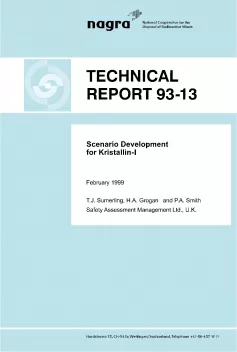
Technical Report NTB 93-13
Scenario Development for Kristallin-I
This report describes the scenario development for the Kristallin-I Safety Assessment, which is an assessment of the post-closure radiological safety of a repository for vitrified high-level radioactive waste sited in the crystalline basement of Northern Switzerland.
The report:
- summarises the relevant Swiss regulatory criteria and guidance, discusses the Nagra approach to safety assessment as it affects scenario development, and outlines the scenario development procedure;
- summarises the Kristallin-I disposal concept and the current understanding of the potential siting region, and describes the Kristallin-I "safety concept", i.e. the design performance of the engineered barriers and the expected contribution of the engineered and geological barriers to long-term safety;
- describes the development of a catalogue of features, events and processes (FEPs) relevant to the long-term safety of the system and the synthesis of these into a conceptual model of the overall behaviour of the system;
- sets out the approach to identifying the scenarios that should be considered in safety assessment calculations. A Reference Scenario is defined, based on the expected behaviour of the engineered barriers and a continuation of present-day conditions of the natural and human environments. The assumptions underlying this scenario and its treatment with available models are defined, and alternative assumptions are discussed. Hence, additional cases for quantitative evaluation are identified. Processes that deserve consideration in the future but are not included in present models are also identified – "reserve FEPs" and "open questions".
- summarises the cases for quantitative evaluation which include the Reference Scenario, parameter variations within the Reference Scenario, alternative model assumptions within the Reference Scenario, and alternative scenarios. A case for robust safety demonstration is defined; reserve FEPs and open questions are discussed.
The main text is supported by appendices which: set down screening arguments used; illustrate by means of influence diagrams the current understanding of the Kristallin-I disposal system; present the catalogue of FEP descriptions and references; describe an audit of the Kristallin-I FEP catalogue against FEP lists used in other safety assessment projects; set down the assumptions of the Reference Scenario; and provide an analysis of how each FEP is treated in Kristallin-I safety analysis calculations.
